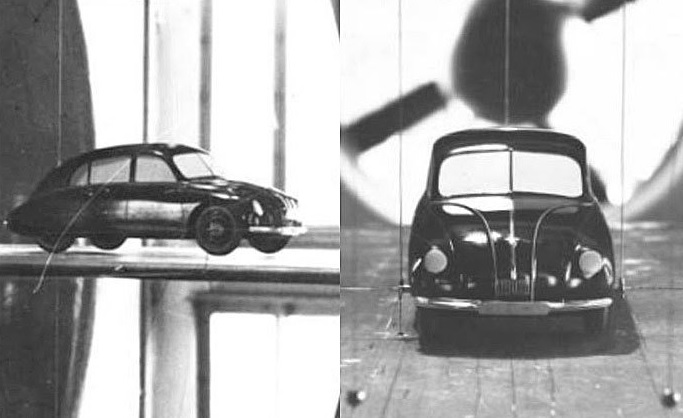This Tatra is interesting not only in appearance or construction, but also in its time of origin, as it was born in a somewhat “wild” period shortly after the Second World War. But her name is also interesting.
Originally, like its predecessors, it was to have a numbering with a “lucky” seven at the end: Tatra 107. Already in the autumn of 1947, before serial production, it was named Tatra 600, which was associated with assigned the number 6 to the beginning. Just remember the following 603 or 613.
At the same time, the name Tatraplan also appeared, which was a pun referring to the graceful body resembling airplanes. In addition, the aircraft appeared on a promotional leaflet for the car.
The development of the later Tatraplan, which was intended as a more affordable middle-class car, began at the end of World War II. The aerodynamic body and a flat four-cylinder at the rear were taken into account.
The first prototype of the new car was completed in December 1946, the second prototype followed in March 1947. Unfortunately, the prototypes showed certain shortcomings, in addition to a weak engine, mainly instability due to the design of the rear axle, which was formed by swinging axles. Therefore, the designers under the leadership of the then only 31-year-old Vladimír Popelář had to return to the drawing boards and reworked the technology. The famous Hans Ledwinka, with whom the designers went to prison, was also to take part in the modifications. He was in it after being convicted of alleged collaboration with the Germans.
The result of the work was shown in the autumn of the same year, when a five-piece series of prototypes with the internal designation T2-107 was built. These cars were already approaching the later production model with spherical headlights, smaller fins at the stern or cold air traps on the roof. The four-cylinder petrol engine was mounted in three silent blocks by means of a fork extending from the central supporting spine, while its volume increased from 1750 cm3 to 1952 cm3. At the same time, its output also increased, from the original 29 kW to 38 kW. The car managed to reach a speed of 130 km / h.
And on June 24, 1948, production began, albeit in temporary conditions. Over the next few months, the shortcomings are gradually eliminated – for example, the cooling system is changed or the rear axle is strengthened.
In 1950, however, the highest party positions decided to move production to AZNP to Mladá Boleslav, where the production of passenger cars was to be centralized, while the Kopřivnice Tatra was to focus on the production of trucks. In the spring of 1951, the last pieces of Tatraplan were created in Kopřivnice, with the fact that in Mladá Boleslav production began to start only in the autumn of the same year. At first glance, the Mladá Boleslav cars were recognizable thanks to the rounded edge of the rear lid, which replaced the pointed solution.
The following year, however, the production of the Tatra 600 was terminated. The quality deteriorated significantly after the relocation of production, which is often explained by the Tatras by the fact that the Škoda people simply did not want the Tatraplan. Whatever the reason for the spoiled cars, the truth is that the poor quality and failure rate significantly affected sales abroad. These were key, a third of the 6,342 pieces made (of which 2,100 in Mladá Boleslav) went outside the country. The largest customer was Austria (435 cars), many cars also went to China, Germany, Sweden and even Canada.
Despite not very long life, Tatraplan made a significant contribution to the history of the Czechoslovak automotive industry. In addition to interesting design solutions, the 4,540-meter-long and 1,200-kilogram Tatra truck still impresses with its appearance and bodywork with a drag coefficient of 0.32.
If you are also one of the admirers of Tatraplan, then you will certainly be interested in photos from the development of this car. We found them on Facebook and when we saw them, it was clear to us that we had to show them to you as well.
In the pictures you can see, for example, testing the aerodynamic properties of the model in a wind tunnel, six prototypes of the future Tatraplan, a wooden model or, for example, a culvert for a 107 type car, which left the plant on September 6, 1947.
Numerous photos: https://www.auto.cz/galerie/autofun/107636/jak-vznikal-legendarni-tatraplan-podivejte-se-na-prototypy-a-fotky-z-vyvoje-a-testovani?foto=0

